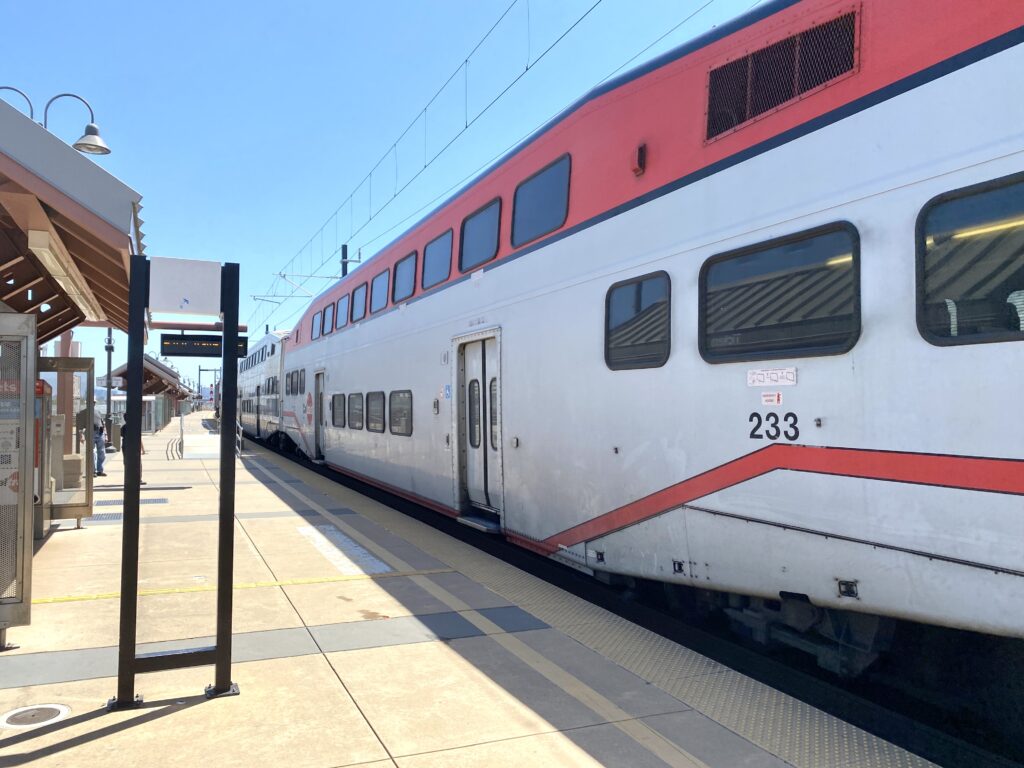After months of deliberation, VTA is joining five major Bay Area transit agencies in supporting a regional funding measure planned for the 2026 ballot.
The VTA board of directors on Thursday voted unanimously to opt into Senate Bill 63, which would allow transit agencies or voter initiatives to put a regional half-cent sales tax on the 2026 ballot. VTA employees projected the tax could bring in $264 million annually over its 14-year span — an enticing financial boost as the agency grapples with looming multimillion-dollar deficits.
Some directors, including Vice Chair and San Jose Mayor Matt Mahan, also stressed the need to look for other funding mechanisms, which was echoed by VTA Assistant General Manager Greg Richardson.
“We have to got to do something to change what is being shown as deficits over the next 10 years, 14 years,” Richardson said. “We can at least know that we can address whatever’s in front of us for a relatively short period of time with this measure … providing us enough time to start developing those changes necessary to the business model and to the things we’ve gotta do as an agency.”
SB 63 is spearheaded by state Sens. Scott Wiener and Jesse Arreguín. The bill passed the state Senate along party lines in June and is now in the Assembly. It needs to pass through the legislature by Sept. 12 to be considered and signed by Gov. Gavin Newsom. Five other transit agencies could benefit from the tax: AC Transit, Caltrain, BART, San Francisco MUNI and SamTrans — San Mateo County’s transportation agency, whose board of directors voted Wednesday to opt in.
VTA employees emphasized funding would benefit the agency directly as well as regional partners and programs to improve connectivity. About 5% of the revenue would go toward projects in the Metropolitan Transportation Commission’s Transit Transformation Action Plan, such as making fare payment methods more consistent and streamlined across the various transit agencies.

VTA directors’ foremost concern prior to opting in had been ensuring funds generated in Santa Clara County returned to benefit the county. After robust discussions with Wiener and Arreguín, VTA officials said the percentage of returning revenue was raised to 94.75% from 89%. Caltrain will be getting about $75 million of VTA’s revenue as well to cover the agency’s funding obligations.
With VTA on board, there’s more support for the bill as it moves through the Legislature. Directors are more worried about the economic climate and getting voters to the poll, given Santa Clara County’s recent decision to put a five-eighths cent sales tax on the 2025 ballot.
“I’m very concerned about the increase in taxation for our residents and people who are buying things, which is how we’re paying for sales tax,” VTA Director and San Jose Vice Mayor Pam Foley said. “Having said that, this is a good use of funds.”
Transit advocates from around the Bay Area rallied around SB 63, claiming the millions generated would help stabilize VTA’s precarious budget alongside supporting other transit agencies, such as BART and Caltrain, which face fiscally uncertain futures. South Bay transit advocate Harry Neil said VTA and SamTrans opting into the bill shows how heavily supported and needed this revenue stream is for Bay Area transit.
VTA employees said joining SB 63 will better address more immediate financial concerns, but other revenue sources are scheduled to sunset soon, meaning the agency might revisit renewal in the future. For example, the 2000 Measure A half-cent sales tax is scheduled to sunset in 2036. It’s expected to bring in $290 million in fiscal year 2025 to fund operations and 14 capital projects, including the BART Silicon Valley expansion.
Polling from VTA released in May found either measure would be supported by about 57% of voters. However, renewing Measure A would need a 67% vote, while a voter initiative under SB 63 would need a simple majority. VTA Chief Government Affairs Officer Beverly Greene said at the meeting the agency plans to conduct more polling early next year.
 Dozens of speakers called in to support the bill, and Neil said he was surprised the board voted unanimously to opt in given previous concerns. However, he pointed out the decision shows the dire financial straits local transit agencies are facing and the capacity to grow, as ridership patterns move from relying on commuters to more regional approaches.
Dozens of speakers called in to support the bill, and Neil said he was surprised the board voted unanimously to opt in given previous concerns. However, he pointed out the decision shows the dire financial straits local transit agencies are facing and the capacity to grow, as ridership patterns move from relying on commuters to more regional approaches.
“Commuter rail is a thing only really in North America, and regional rail is around the world. We are moving more toward that model and we are seeing some massive benefit,” Neil told San José Spotlight. “SB 63 will be very good for our region and especially good for VTA, because we probably have the most need to grow.”
Contact B. Sakura Cannestra at [email protected] or @SakuCannestra on X.



Leave a Reply
You must be logged in to post a comment.